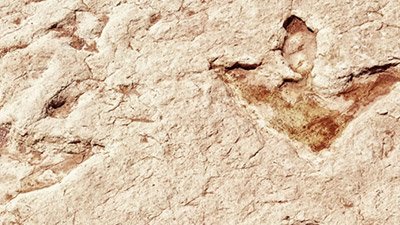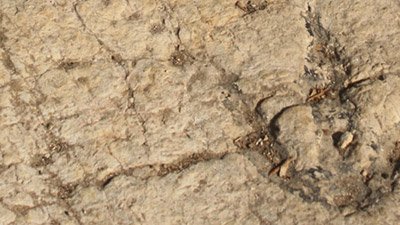
Matching Footprint Found Under Protoceratops
Skeleton in the closet puts its foot down.
News Source
Languishing for half a century in a Polish Museum, an ordinary Protoceratops sat on its secret until paleontologists needed an exhibit for the Polish Academy of Science. While preparing the specimen, Grzegorz Niedzwiedzki and Tomasz Singer noticed a matching footprint fossilized beneath the dinosaur’s pelvic bones. The dinosaur fossil came from the Gobi Desert, which is home to many fossilized footprints, but none like this one.
“The Djadokhta Formation of the Gobi Desert [where this specimen was found] is known for the number and diversity of dinosaur and other vertebrate bones and skeletons found there, but only theropod, hadrosaur and supposed ankylosaurid footprints have been reported from this stratum. . . . Although Protoceratops is an extremely common dinosaur in Mongolia, its footprints have never previously been reported from the Late Cretaceous of the Gobi Desert.”1 Furthermore, the authors of the report published in Cretaceous Research write, “This is possibly the first find of a dinosaur track in close association with an articulated skeleton.”2
This is possibly the first find of a dinosaur track in close association with an articulated skeleton.
Fossil footprint identification is not as simple as it sounds, explains Denver geology professor Martin Lockley. “Generally, we find it very hard even to match dinosaurs with their footprints at the species level,” he explained. “We have a couple of examples in the literature where we say, ‘we're almost certain that this footprint belongs to this species’, but this is an animal actually dead in its tracks.”
There could be a lot more examples waiting to be found, but the practicalities of fossil preparation may get in the way. “Traditionally,” Lockley adds, “palaeontologists look for nice skeletons, and in order to get those out of the rock, they're discarding the matrix. So lots of tracks have been overlooked.”
The uniqueness of the discovery rests in the fact that the footprint was found with a dinosaur skeleton at all. Dinosaur trackways are typically not found in the same deposits as skeletons. According to London paleontologist Paul Barrett, “Trackways usually come from beach deposits, [but] bones are normally found in river channels, where perhaps the animals drowned and were quickly buried and preserved.”
Lockley hopes the find will prompt paleontologists to look harder for these associations because he believes tracks will yield a lot of information about the lives of their owners. He says, “When palaeontologists deal with skeletons, they're dealing with death and decay. But with tracks you can tell how much it weighed, how it moved, if it was running or walking. You can even tell if it was limping. With tracks you're dealing with the living animals.”
Well, at least you’re reminded that they used to be. After all, as Professor Lockley adds, “I think a lot of these dinosaurs could have been caught in flash flooding. . . . If you want to become a fossil, you need to get buried quickly.”
Well, the same can be said of a fossilized footprint. The footprint, having been pressed into a material with reasonably cement-like qualities, would need to be rapidly buried. So how, many people ask, can a footprint get preserved as a fossil? For those that believe slow geologic processes cause fossilization, there is the question of why footprints wouldn’t erode or be simply dissipated by lengthy exposure to the elements before they could be preserved. For young-earth creationists who believe that most fossils formed during the Flood or in its aftermath, there is the question of why the turbulent Floodwaters failed to obliterate the footprints.
The carbonate in the Gobi sandstone suggests a time when it was subjected to mineral-laden water, consistent with the time of the global Flood.
The article in Cretaceous Research states, “The track is preserved in reddish-brown sandstone, cemented by carbonate and silica matrix.”3 The carbonate would give the matrix its cement-like quality. But carbonate is a mineral generally associated with mineral-laden water. The Gobi is now a desert. According to the journal article, the Gobi “preserves an arid habitat of sand dunes, with little fresh water apart from oases and arroyos [gully cut by water].”4 The carbonate in the Gobi sandstone suggests a time when it was subjected to mineral-laden water, consistent with the time of the global Flood.
There is additional evidence that the Gobi and the tracks it preserves were once underwater. Sand blown by wind characteristically deposits itself in banded cross-beds at an angle of 30-34 degrees. Sand carried by underwater waves typically deposits itself at an angle of 25 degrees. The cross-beds in the Djadokhta Formation’s sandstone are “consistently at an angle of 25 degrees”5 indicative of a history of underwater deposition.
So, how could the Flood explain track preservation? When the Floodwaters were rising—something Genesis 7:17–18 documents they did for many days—there would have been surges and regressions of water under the influence of volcanic-related seismic activity and tides. Surges of ocean water would have brought in carbonate-laden water and left behind sediments into which animal footprints could have been pressed. Additional surges bearing more loads of sediment could then rapidly bury tracks set in the cement-like carbonate-rich sand, preserving the fossil impressions. (Flash floods usually wash things away rather than deposit loads of sand for rapid burial.)
This Flood model of track fossilization also explains why tracks are rarely preserved with their owners. Fleeing animals overwhelmed by later surges of water would usually be carried away for deposition elsewhere. Apparently, this particular dinosaur—assuming the skeleton and the track belong to the same individual—experienced its death moments after making this track. Interestingly, since Professor Lockley reminds us that we can make some educated guesses about behavior based on footprints, we should note in the photographs and diagrams6 that only the front part of the foot left its impression to be preserved. This suggests the animal may have been on its tiptoes in high water or climbing uphill—perhaps to escape rising water—just before it succumbed.
The Bible does explain what we see in the world. Read more about the ways footprints can fossilize in “Fossilized Footprints—A Dinosaur Dilemma.”
Further Reading
For More Information: Get Answers
Remember, if you see a news story that might merit some attention, let us know about it! (Note: if the story originates from the Associated Press, FOX News, MSNBC, the New York Times, or another major national media outlet, we will most likely have already heard about it.) And thanks to all of our readers who have submitted great news tips to us. If you didn’t catch all the latest News to Know, why not take a look to see what you’ve missed?
(Please note that links will take you directly to the source. Answers in Genesis is not responsible for content on the websites to which we refer. For more information, please see our Privacy Policy.)
Footnotes
- Grzegorz Niedźwiedzkia, Tomasz Singer, Gerard D. Gierliński, and Martin G. Lockley, “A Protoceratopsid Skeleton with an Associated Track from the Upper Cretaceous of Mongolia,” Cretaceous Research 33, no. 1 (February 2012): 7–10, http://www.sciencedirect.com/science/article/pii/S0195667111000966.
- Ibid.
- Ibid.
- Ibid.
- Andrew A. Snelling, Earth’s Catastrophic Past (Houston, Texas: Institute for Creation Research, 2010), 548.
- Niedźwiedzkia et al., “A Protoceratopsid Skeleton . . .”
Recommended Resources

Answers in Genesis is an apologetics ministry, dedicated to helping Christians defend their faith and proclaim the good news of Jesus Christ.
- Customer Service 800.778.3390
- © 2024 Answers in Genesis





